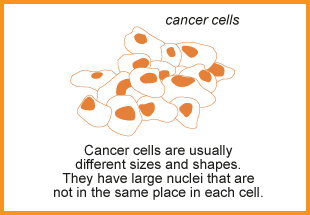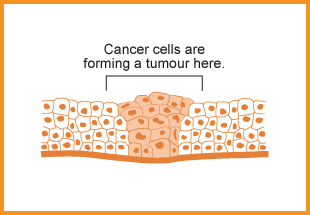What is cancer?
Cancer is a common condition. It is estimated that one in two people will develop some form of cancer during their lifetime. Being aware of general signs and symptoms linked to the condition can help in early detection. This is important because the earlier a cancer is detected, the better the chances of successful treatment.
The most common types of cancer found in men were prostate, bowel (colorectal) and lung. In women, the most common cancer types were breast, lung and bowel (colorectal).
Cancer is the general name for a group of diseases which affect the body’s cells. Although there are many different kinds of cancer, all cancers are caused by abnormal cells growing out of control. Cancer cells can invade other tissues through the blood and lymph systems. Untreated cancers can cause serious illness and death.
What are cells?
- Our bodies are made up of tiny building blocks called cells.
- Usually, cells grow in a controlled way.
- Each cell knows exactly what to do, when to do it and when to stop.
- During our early years, normal cells divide faster to allow us to grow.
- After we become an adult, most cells divide only to replace worn-out or dying cells or to repair injuries.
How does cancer begin?
Cancer begins when cells in a part of the body divide without control.Unlike normal cells, cancer cells keep on dividing, forming a lump or tumour.
Tumours are either benign (non- cancerous) or malignant (cancerous).
Benign tumours can cause problems, but they are not normally as dangerous as cancer.
In a malignant tumour, the cancer cells can spread beyond the original area of the body.
If the tumour is left untreated, it may spread into surrounding tissue.
How does cancer spread?
- Cancer cells can also spread to distant parts of the body.
- They normally do this by getting into the bloodstream or the lymphatic system.
- The lymphatic system makes and stores cells that fight infection.
- The bloodstream and lymphatic system are, if you like, transport networks in the body.
- Cancer cells have the ability to move around the body using these networks.
- If the cells get stuck somewhere, they can begin growing in this new place, forming secondary tumours or metastases.
How do cancers differ?
- There are many different kinds of cancer - with different signs, symptoms, treatments, and outcomes.
- Different types of cancer can behave very differently, eg lung cancer and skin cancer grow at different rates and respond to different treatments.
- This is why people with cancer need treatment that is aimed at their kind of cancer.
- The most common sites in which cancer develops include the skin, lungs, breasts, prostate, and colon and rectum (large bowel).
* Figures from Northern Ireland Cancer Registry



